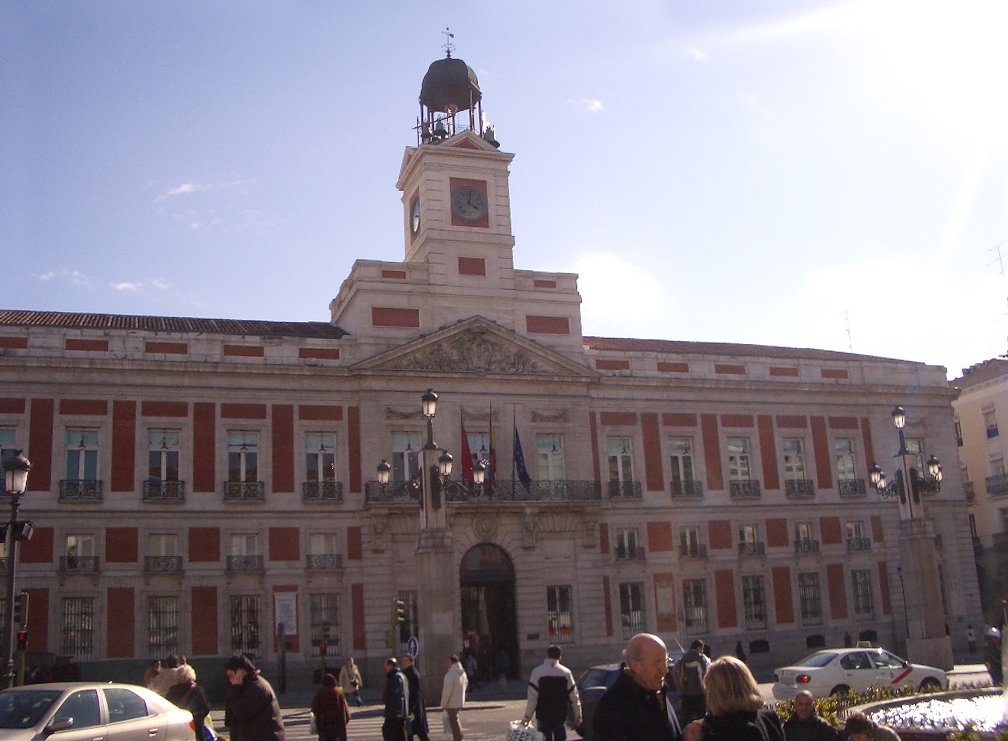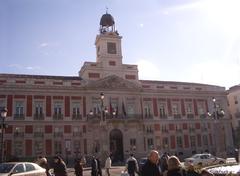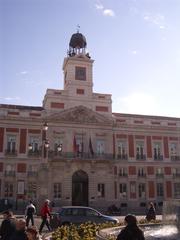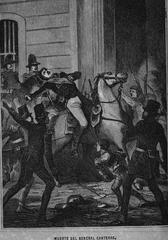
Royal Post Office Madrid: Visiting Hours, Tickets & Historical Significance
Date: 14/06/2025
Introduction
Nestled in the vibrant heart of Madrid’s iconic Puerta del Sol, the Royal Post Office (Real Casa de Correos) stands as one of the most significant historical and civic landmarks in Spain. Built between 1760 and 1768 under the guidance of French architect Jacques Marquet and commissioned by King Carlos III, this neoclassical masterpiece is not only a testament to Madrid’s architectural heritage but also a living witness to the country’s evolving history and traditions.
Today, the Royal Post Office serves as the seat of the Presidency of the Community of Madrid, while its famous clock tower marks Spain’s most celebrated New Year’s Eve tradition. This guide provides detailed insights into its architectural features, historical significance, visitor information, and nearby attractions, ensuring a memorable and informed visit.
For official updates and further details, visit Spain’s official tourism website and Madrid tourism.
Table of Contents
- Architectural Features
- Historical and Symbolic Importance
- Civic Role and Cultural Identity
- Visiting Information: Hours, Tickets, Accessibility
- Travel Tips and Nearby Attractions
- Frequently Asked Questions (FAQs)
- Summary and Visitor Tips
- Sources
Architectural Features
Façade and Structure
The Royal Post Office’s façade combines red brick and white stone, creating a symmetrical, rectangular design typical of 18th-century Madrid civic architecture. The main entrance is accented by a grand doorway, a balcony, and a high-relief sculpture bearing Charles III’s royal coat of arms, underscoring its royal origins (Spain.info).
Clock Tower
A defining element is the 19th-century clock tower, added after the original construction and famously associated with Spain’s New Year’s Eve “Twelve Grapes” tradition. The clock, crafted by Losada and inaugurated by Queen Isabel II in 1866, is a national symbol, broadcasting the chimes that unite millions in celebration each December 31st.
Layout and Interior
The building’s rectangular plan features two central courtyards that provide natural light and ventilation. Inside, original stone staircases, vaulted ceilings, and decorative moldings remain, particularly in ceremonial rooms adorned with classical columns, stucco, marble, and polished wood.
Historical and Symbolic Importance
Kilometre Zero
Just outside the Royal Post Office is Spain’s Kilometre Zero marker—the official point from which all Spanish radial roads are measured. This plaque is a popular photo spot and marks the geographic and symbolic heart of Spain (Spain.info).
Witness to History
Since its completion, the Royal Post Office has played a central role in Spanish history. It has served as the central hub for the postal system, housed Spain’s first electric telegraph in 1846, and acted as the headquarters for the Ministry of Interior and State Security during Francoist Spain. Its basement has a somber history as a site of political detention. The building has also witnessed key events such as the proclamation of the Second Republic, the War of Independence, and numerous social movements (Guía del Ocio).
Civic Role and Cultural Identity
Seat of Regional Government
Since the late 20th century, the Royal Post Office has been the administrative headquarters of the Community of Madrid, embodying the city’s adaptive reuse of historic structures for modern governance (Guía del Ocio).
Center of Public Life
Puerta del Sol, with the Royal Post Office as its anchor, is a focal point for public gatherings, demonstrations, and civic celebrations. The building is the backdrop to many pivotal moments, from political rallies to cultural festivities (Facts.net), (Patrimonio y Paisaje Madrid).
New Year’s Eve Tradition
Thousands gather each December 31st to eat twelve grapes in sync with the clock’s chimes, a tradition broadcast nationwide and deeply embedded in Spanish culture (Guía del Ocio).
Visiting Information: Hours, Tickets, Accessibility
Hours and Access
- Exterior and Plaza: Accessible 24/7.
- Interior: Generally not open to the public, except for special cultural events, Madrid’s Open House, or guided tours. During these occasions, typical visiting hours are 10:00 AM to 6:00 PM (Guía del Ocio).
- Tourist Information Office: Open Monday–Friday 8:00 AM–7:00 PM, Saturday 8:00 AM–12:00 PM; closed on public holidays (ESMadrid.com).
Tickets
- No ticket is required to admire the exterior, visit Puerta del Sol, or enter the tourist office.
- Entry to the interior during open days or special tours is usually free, but some exhibitions may require booking in advance.
Accessibility
- The area around the Royal Post Office is pedestrian-friendly and wheelchair accessible.
- The Sol metro station (Lines 1, 2, 3) offers elevators and ramps for easy access.
Travel Tips and Nearby Attractions
- How to Get There: The Sol metro station is adjacent. Numerous bus lines and bike rental stations are nearby.
- What to See:
- The clock tower, especially at night.
- The Kilometre Zero plaque.
- The Bear and Strawberry Tree statue (El Oso y el Madroño).
- Plaza Mayor, Gran Vía, and Mercado de San Miguel—all within walking distance.
- Safety: Puerta del Sol is a busy area; stay mindful of your belongings, particularly during large events.
- Best Times to Visit: Early mornings and late evenings for fewer crowds; New Year’s Eve for a unique atmosphere.
Frequently Asked Questions (FAQs)
Q: Can I visit inside the Royal Post Office Madrid?
A: The interior is generally closed except for special tours or cultural events. The tourist office on the ground floor is accessible to the public.
Q: Do I need tickets to visit?
A: No tickets are required for the exterior or tourist office. Guided tours or exhibitions may require advance reservation.
Q: Is it wheelchair accessible?
A: Yes, the plaza and tourist center are accessible.
Q: What other attractions are nearby?
A: Plaza Mayor, Gran Vía, the Bear and Strawberry Tree statue, Mercado de San Miguel, and the Prado Museum.
Q: When is the New Year’s Eve tradition?
A: December 31st, with the clock tower’s chimes marking midnight in a nationally televised event.
Summary and Visitor Tips
The Royal Post Office Madrid (Real Casa de Correos) is an emblematic landmark that blends neoclassical architecture, centuries of historical significance, and vibrant civic life. While its interior is rarely open to the public, the building’s exterior, iconic clock tower, and central location make it a must-see for visitors to Madrid. From witnessing the famous New Year’s Eve celebration to exploring nearby historic sites, a visit to Puerta del Sol’s Royal Post Office offers a rich experience at the heart of Spain’s capital.
To make the most of your visit:
- Check official tourism websites for up-to-date hours and special event access.
- Visit early or late in the day for optimal photos and fewer crowds.
- Explore surrounding attractions and enjoy the lively atmosphere of Madrid’s most famous square.
For more information, download the Audiala app and follow local tourism resources.
Sources and Further Reading
- Spain.info – Official Tourism Website
- Guía del Ocio – Real Casa de Correos Madrid
- Facts.net – 37 Facts About Madrid
- Patrimonio y Paisaje Madrid – Real Casa de Correos
- ESMadrid.com – Tourist Information Real Casa Correos




































































































